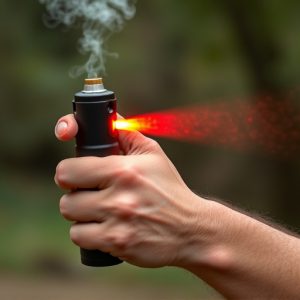Pepper Spray Training for Beginners: Safe Crowd Control Techniques
Pepper spray training is a critical component of law enforcement education, equipping officers with…….
Pepper spray training is a critical component of law enforcement education, equipping officers with a powerful yet non-lethal tool for crowd control. For beginners, this training teaches safe and effective usage techniques, de-escalation tactics, and responsible pepper spray application to minimize risks and ensure public safety during demonstrations and volatile situations. Key aspects include understanding spray types, potency, deployment range, wind considerations, ventilation, protective gear, and regular practice sessions.
In today’s diverse and sometimes unpredictable social climate, understanding crowd control tactics is paramount. Among these, pepper spray stands out as a powerful tool used by law enforcement worldwide. This article delves into the multifaceted world of pepper spray, exploring its uses, effects, and role in crowd control. We also provide essential guidelines for beginners’ training, safety precautions, and responsible use, ensuring a comprehensive understanding of this controversial yet critical subject.
- Understanding Pepper Spray: Its Uses and Effects
- The Role of Pepper Spray in Crowd Control
- Effective Pepper Spray Training for Beginners
- Safety Precautions and Responsible Use Guidelines
Understanding Pepper Spray: Its Uses and Effects
Pepper spray, officially known as oleoresin capsicum (OC) spray, is a powerful crowd control tool used by law enforcement agencies worldwide. It’s designed to disable and de-escalate situations involving aggressive individuals or large crowds. Unlike traditional tear gas, which can affect vision and breathing, pepper spray primarily targets the eyes, causing temporary blindness and intense irritation. This disruption allows officers to gain control and safely manage potential threats.
For beginners in law enforcement or those interested in self-defense, understanding pepper spray involves grasping its correct usage and potential side effects. Proper Pepper Spray Training for Beginners teaches techniques like aiming at the face and holding the canister correctly. It’s crucial to emphasize that while effective, pepper spray should be used as a last resort when other de-escalation methods have failed or are not feasible, ensuring public safety remains the top priority.
The Role of Pepper Spray in Crowd Control
Pepper spray has become a staple in crowd control tactics employed by law enforcement agencies worldwide. Its effectiveness lies in its ability to quickly disrupt and disperse large gatherings, making it a valuable tool for managing public events and maintaining order. For beginners in law enforcement or those interested in understanding crowd control measures, pepper spray training is essential. This training equips individuals with the knowledge and skills to handle and deploy pepper spray safely and efficiently.
The use of pepper spray offers several advantages in crowd control scenarios. It is non-lethal, allowing officers to subdue and control individuals without causing permanent harm. This is particularly crucial when managing aggressive or volatile crowds where the primary goal is to prevent injury and maintain public safety. Pepper spray training for beginners teaches them about the different types of pepper spray, their potency, and how to assess a situation to determine its suitability as a crowd control measure. It also covers proper usage techniques, including aiming, distance, and follow-up actions, ensuring that every officer is prepared to handle potential risks effectively.
Effective Pepper Spray Training for Beginners
For those new to pepper spray, proper training is essential for effective crowd control and ensuring safety during demonstrations or volatile situations. Pepper spray training for beginners should cover the basic mechanics of deployment, including understanding the spray’s range, wind considerations, and safe distance from targets. Hands-on practice in a controlled environment allows individuals to become comfortable with the equipment, learn proper grip and activation techniques, and develop reflexes for quick response.
During training, beginners should also be educated on de-escalation tactics and crowd control strategies that complement pepper spray usage. Understanding when and how to use pepper spray responsibly, while also employing communication and non-lethal force alternatives, is crucial. Scenario-based training can help novices build confidence in their abilities and make informed decisions under pressure, ensuring a more controlled and safe environment for all involved.
Safety Precautions and Responsible Use Guidelines
When police deploy pepper spray as a crowd control measure, it’s crucial to adhere to strict safety precautions and responsible use guidelines. Pepper spray training for beginners should emphasize the importance of targeted application, ensuring minimal exposure to bystanders and non-target individuals. This includes proper ventilation, wearing protective gear, and learning to activate the spray at safe distances.
Officers must be trained to recognize and respect individual vulnerabilities, such as respiratory conditions or sensitive skin. Responsible use involves understanding the spray’s effects, which can last for several minutes, and de-escalation techniques to prevent unnecessary harm. Regular practice sessions are vital to hone these skills, ensuring that police actions remain proportionate and safe during crowd management scenarios.
Pepper spray has established itself as a valuable tool in crowd control, but its effective and safe use requires proper training. The article has explored various aspects of pepper spray, from its uses and effects to safety precautions and responsible guidelines. For those new to this subject, understanding the fundamentals of Pepper Spray Training for Beginners is essential. By adhering to these practices, users can ensure public safety while leveraging pepper spray’s capabilities during crowd control situations.


